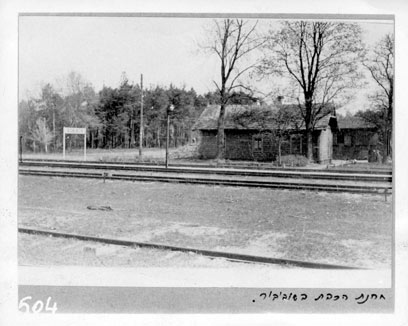
Sobibor's last survivor: There was no time to fear, only to live
Israeli archeologist tells Ynet about excavation that uncovered extermination camp's gas chambers, including finding of victims' personal items, among them a golden wedding ring.
In 1943, the Nazis had buried the deadly showers and planted a forest on top to cover their murderous deeds. Some 250,000 Jews were murdered in Sobibor between April 1942 and October 1943.
"I cannot believe they discovered them," said Rosenfeld. "The Nazis destroyed the entire camp. It's hard to imagine there is anything left there now," he added.
Rosenfeld was born in Ukraine and was recruited to the Red Army in 1940. A year later he was captured by the Germans and was sent along with 230 Jewish prisoners to build a labor camp in Minsk. Later he was transferred to Sobibor.
Related stories:
- Archaeologists unearth Sobibor's gas chambers
- Bones of Jews murdered in Sobibor to be buried
- Sobibor death camp memorial center planned
Rosenfeld, who is currently living in Tel Aviv, added that "in September 1943, we were brought (to Sobibor) from the ghetto in Minsk. Some of us were Jewish soldiers who served in the Russian army and were captured by the Germans."
"The Germans separated the non-Jewish soldiers from the Jewish ones, but they were afraid to shoot us because we were still considered war prisoners. In total, we were 80 Jews from Minsk in Sobibor. We stayed there for 20 days until the uprising, during which I managed to escape," added Rosenfeld.
The uprising that Rosenfeld is talking about saw the death of several SS troops and the escape of 300 prisoners, but most of them were killed or captured in the days that followed. Only 50 of them survived to see the end of the war.
In his testimony, given at the Ghetto Fighters' House Museum, Rosenfeld said that when one of the prisoners asked a German guard at the camp where were the rest of their friends, who were with them on the train, he pointed at the smoking chimney and answered "there."
Rosenfeld went on to say that when the leader of the uprising, Alexander Pechersky, asked him if he is capable of killing a man with an axe, he responded "I am not capable of killing a human being, but I can kill a Nazi." Rosenfeld was 21 years old at the time of the uprising.
"I wasn't afraid, because there was no time to think of fear. I was only thinking about living," added Rosenfeld.
Documenting for generations to come
Israeli archaeologist Yoram Haimi, who discovered the gas chambers' location, told Ynet that what drove him to conduct the excavation was his personal connection to Sobibor.
"Two of my uncles on my mother's side were murdered here and they are the reason I have been digging here for the past seven years.
"When we realized we were in the right place we were extremely excited. Throughout the years, we thought that the gas chambers were where we (eventually) discovered them, but we weren't authorized to dig there," he continued.
"It took us a while to find the chambers, because we are dependent on local authorities. We started our research in 2007 with the primary goal of locating the gas chambers. Over the years we found all sorts of things that were near the gas chambers, but not the chambers. In 2011, after we uncovered the road Jews were led through, we assumed the gas chambers were likely under the layer of asphalt. Up until now, we've been waiting for the asphalt to be remove for the construction of the new visitors center, and as soon as it was removed we found this big structure, that we believe housed the Sobibor camp's gas chambers.
"We started digging in this area two and a half weeks ago and discovered a huge structure with four cells and remains of walls," Haimi said.
"Sobibor is now the only camp in which you could see the original gas chambers, as they were when they were operational. We also know just how many gas chambers there were here," he said.
"As far as we know, 1,000 Jews were forced into eight gas chambers inside these structures in every killing cycle. There are likely four additional cells and we hope to find them in the future," said Haimi.
"So far, there were all sorts of assumptions about the size (of the gas chambers), this is a massive structure," he noted.
According to Haimi, this is the first time that a large structure that includes gas chambers is discovered in one of the three camps built during the 1942 "Operation Reinhard" (Bełżec, Sobibór, and Treblinka).
"These were smaller camps than Auschwitz, but the murder industry worked much more efficiently and almost anyone who was imprisoned in the camp was put to death in the gas chambers," said Haimi.
"Our findings show that the three camps built during Operation Reinhard were completely destroyed. A special team of the Sonderkommando 1005 and continued the work of destroying all remnants of the camp," he added.
"In these structures we found various personal artifacts belonging to the victims and today we discovered a large Star of David made of iron," Haimi added. Earrings and rings were also found where the bodies were washed. "We have a real testimony here, and this is documentation for generations to come," Haimi said.
A golden wedding ring, with Hebrew inscription was one of those personal artifacts.

The find "was very emotional for all of us," Haimi said. "Of course it was for the Jews (among us), but also for the Poles, finding something like this is very special." Haimi noted they keep finding personal belongings.
Along with the gas chambers, the archeologists also found the road the Nazis built to marched their victims to their deaths. "We uncovered the original ramp, which still had wooden beams and nails that kept it together, a very large ramp. A train would come with 1,000 Jews and they needed a large enough place for them to enter the camp through. This ramp, with a pathway and a fence, is leading right to the entrance to camp 2, where selection was made and from there, some were sent to the gas chambers," Haimi said.












